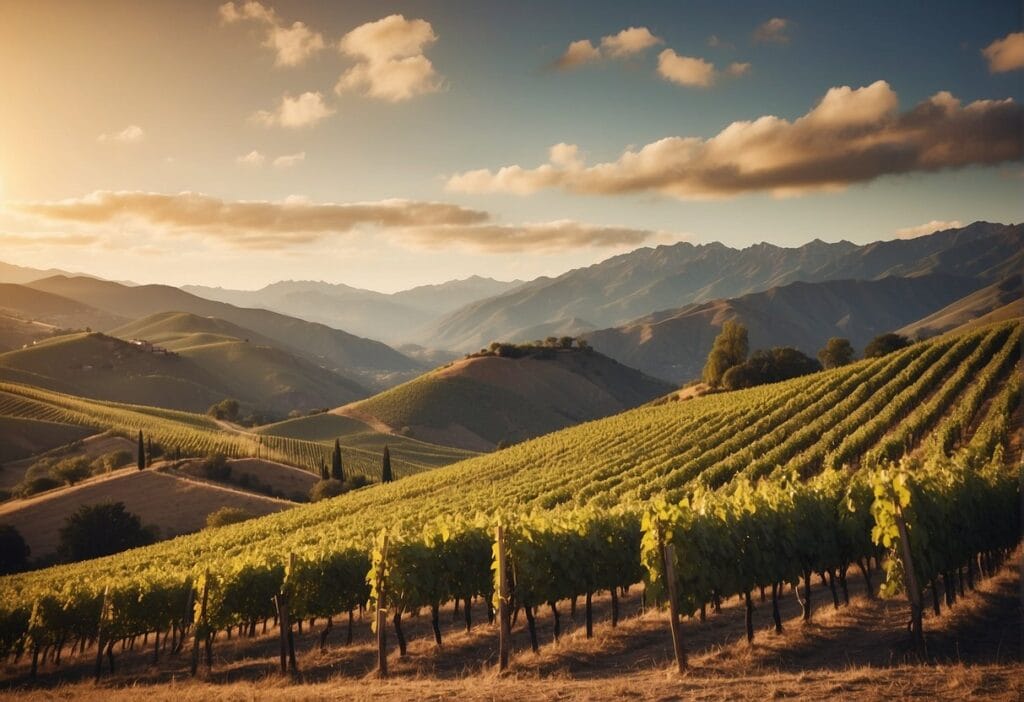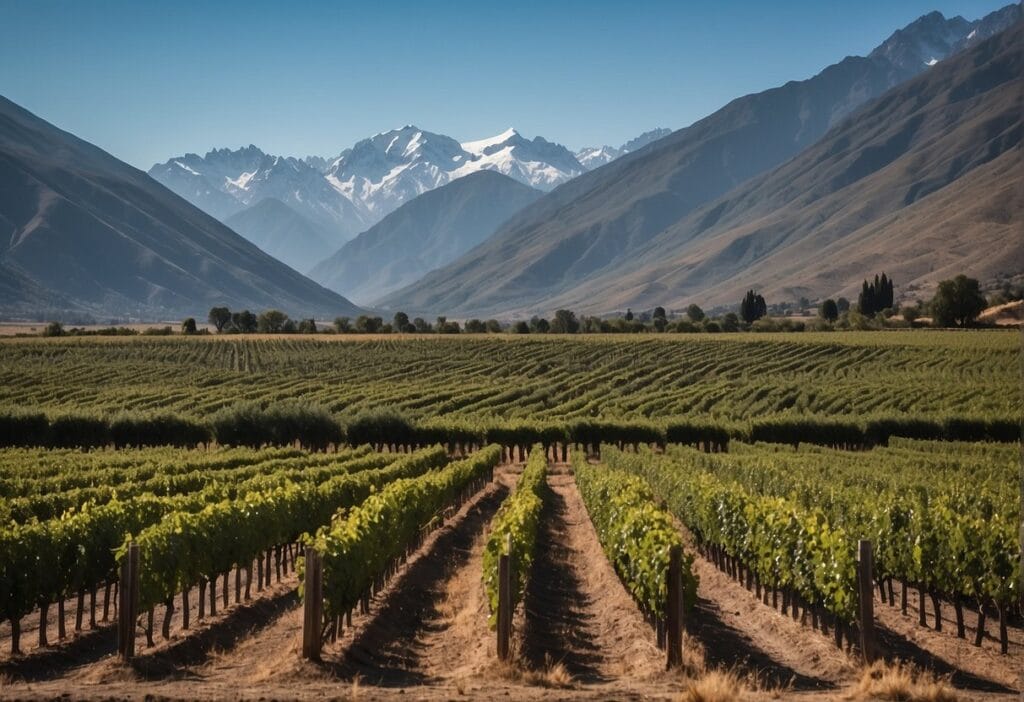Nestled in the northwestern corner of Italy, the Piedmont wine region is renowned for its high-quality wines that encapsulate the essence of the Italian winemaking tradition. With a landscape dominated by rolling hills and the snowy peaks of the Alps as a backdrop, Piedmont, which translates to “at the foot of the mountains,” provides a perfect terroir for a variety of grapes.
The cool climate and misty conditions are especially favorable for the Nebbiolo grape, the star behind the region’s most prestigious wines, Barolo and Barbaresco.
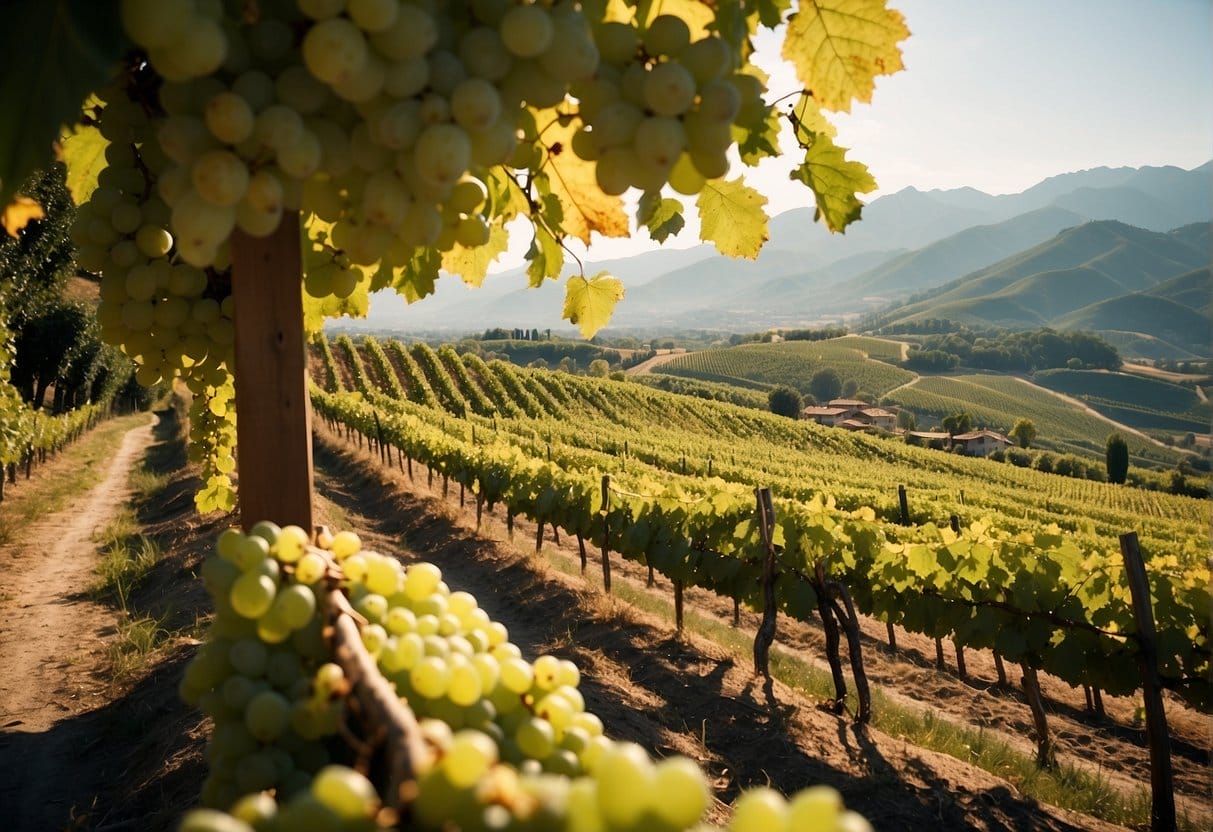
Piedmont is not just about red wines though; the region is also home to celebrated white wines such as Gavi, made from the Cortese grape, and sweet, sparkling Moscato d’Asti. The diversity of wines reflects the complex tapestry of Piedmont’s soil and microclimates, defining each bottle with a unique character.
For connoisseurs and casual drinkers alike, the Piedmont wine region offers an array of wines that pair wonderfully with the rich local cuisine, creating a harmonious marriage of flavors that celebrate both the land and its bounty.
Key Takeaways
- Piedmont is a preeminent wine region in Italy, famed for Nebbiolo-based wines.
- The area features a diverse range of wine styles, including prestigious reds and celebrated whites.
- Local conditions, including geography and climate, significantly shape Piedmont’s wine profile.
Piedmont’s Location and Geography
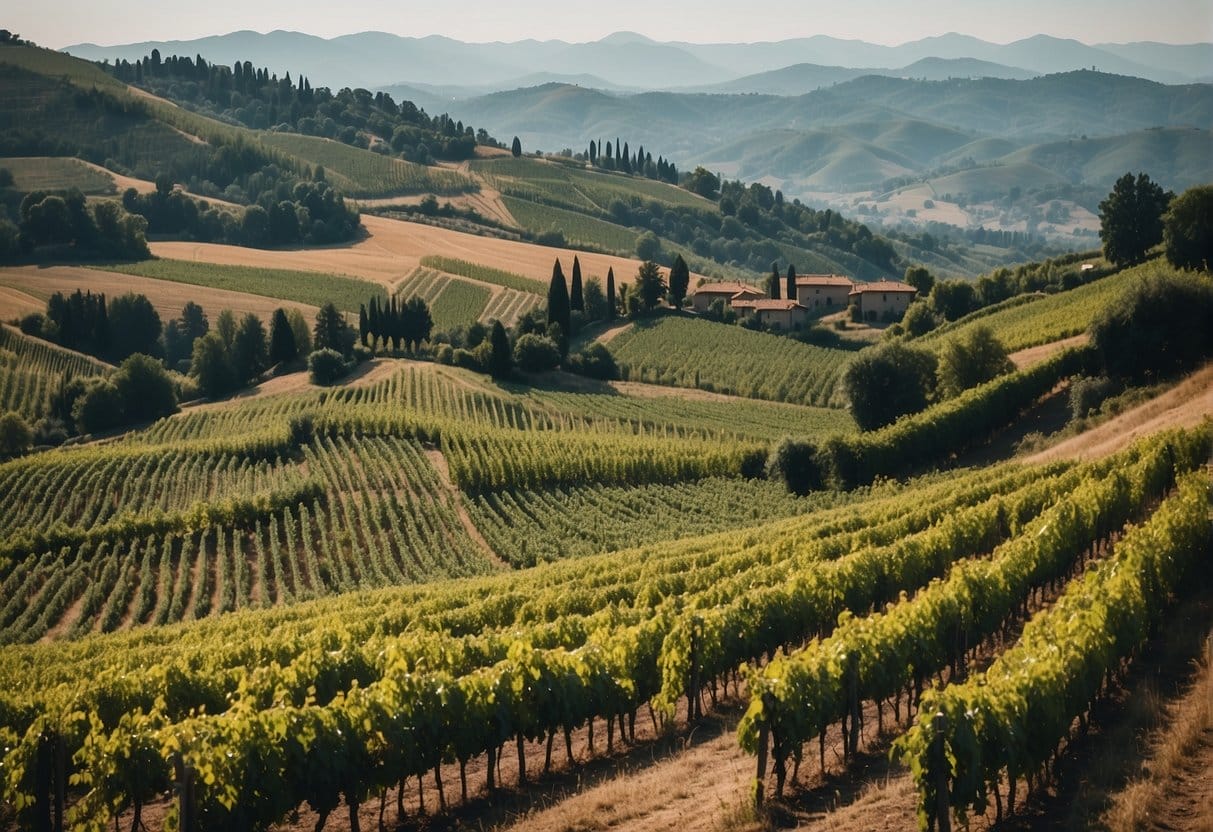
Piedmont is nestled in the northwestern corner of Italy, acting as a hinge between the Mediterranean and the Alps. This region offers you a diverse geographical tapestry that significantly influences its wine production.
Proximity to the Alps and Apennines
The Alps form a majestic northern natural barrier for Piedmont, contributing to the region’s unique microclimates. These towering mountain ranges help protect the vineyards from harsh northern European weather. On the flip side, to the south, the lush Apennines mountains trace Piedmont’s boundary, providing a mix of elevations and terrains that are vital for various wine grape varietals.
Bordering Regions and Countries
Piedmont is bordered by Switzerland to the north, offering a serene backdrop of snow-capped mountains. To the west, France lies adjacent, which not only influences the cultural tapestry of the region but also adds to its strategic winemaking position in Europe. The beautiful landscape of Piedmont is also bordered by the Italian regions of Lombardy to the east and Aosta Valley to the northwest, each contributing to the diversity and richness of the area.
History of Piedmontese Wine
Discover how ancient cultures shaped one of Italy’s most renowned wine regions and learn about the significant wine laws that have contributed to the high-quality standard of Piedmont Wines.
Influence of Ancient Cultures
The legacy of Piedmontese wine can be traced back to antiquity, with its advent credited to the Celtic-Ligurian peoples who introduced viticulture in the 6th century BC. Their wine-making techniques were enhanced over centuries, particularly noted in the 14th century when Pietro de Crescentius recognized Piedmont’s initiative in producing sweet wines reminiscent of Greek styles, by allowing grapes to dry on the vine^1.
Development of Wine Laws
It was only in the 20th century that Italian Wine laws evolved to safeguard the quality and authenticity of Piedmont wines. Wine-making regulations and the creation of DOC/DOCG certifications were pivotal, ensuring that wines you enjoy from this region adhere to strict guidelines, from the grape varieties grown to the methods of production^2.
Grape Varieties and Wine Styles
The Piedmont region is renowned for its diverse array of grapes and wine styles, showcasing distinguished varietals such as Nebbiolo, Barbera, Dolcetto, and others, each offering a unique palette experience.
Nebbiolo and Its Expressions
Nebbiolo is the star of Piedmont’s wine scene, notably in the Barolo and Barbaresco wines, with each expressing the terroir’s nuances. Barolo is celebrated for its robust structure and ability to age, unveiling complex flavors over time. In contrast, Barbaresco, often considered more approachable in its youth, delivers a similar intensity with a notable elegance.
Barbera and Dolcetto
You’ll discover that Barbera is a versatile grape, producing wines that range from light and easy-drinking to deep and full-bodied. On the other hand, Dolcetto wines are typically softer and fruitier, offering a more immediate pleasure with less tannin and a gentle finish.
Other Notable Grapes
Piedmont also boasts a variety of other notable grapes that contribute to its wine diversity: Arneis and Cortese are two aromatic white grapes, with the former often noted for its pear and apple notes and the latter for its crisp acidity and light-bodied wines.
The Moscato grape creates fragrant and sweet wines that are a delight to the senses. Reds like Brachetto and Freisa showcase a range of dry to sweet wines, with Brachetto often used to create sweet, sparkling wines and Freisa offering a more tart profile. Additionally, Malvasia appears in blends, imparting floral and sometimes nutty aromas to the wines.
Key Wine-Producing Zones
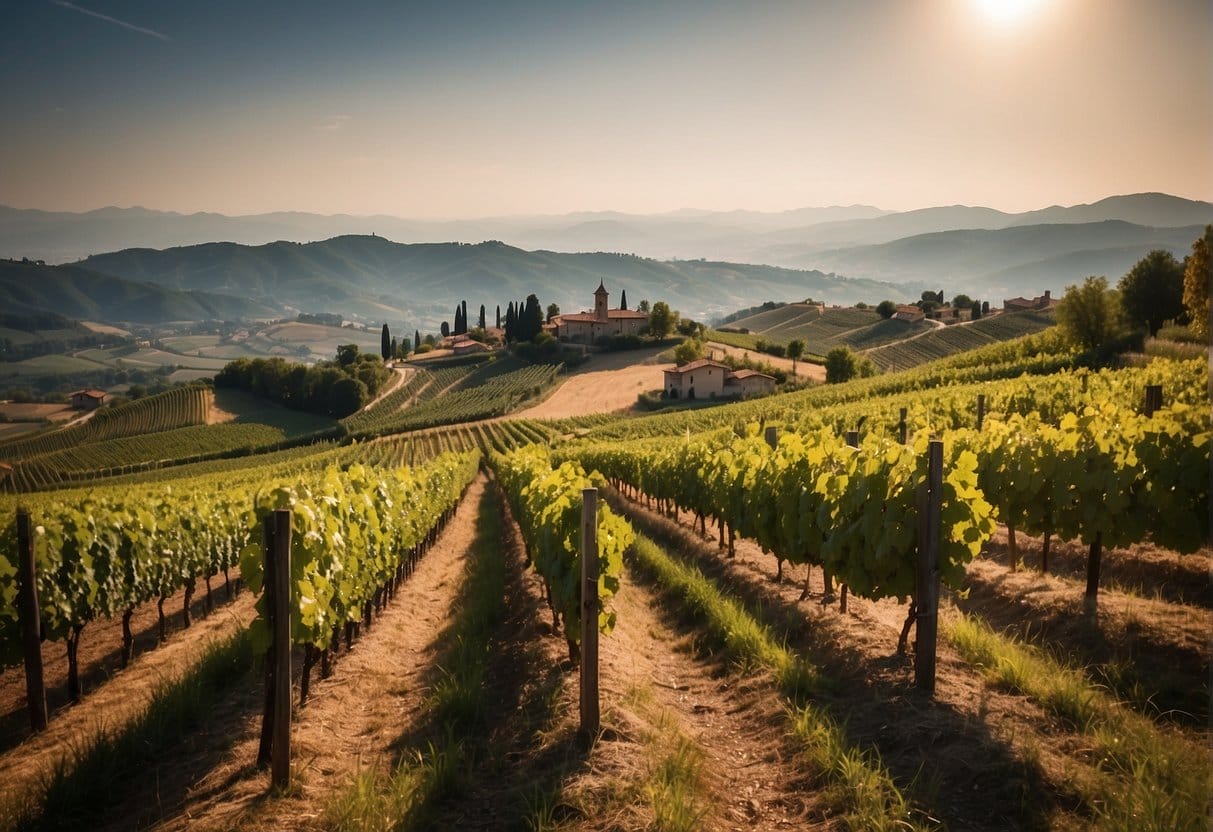
Piedmont, a prestigious region tucked away in the northwest corner of Italy, is home to some of the most diverse and high-quality wines you will find. Every area has its unique signature, from the powerful reds of the Langhe to the effervescent sparkles of Asti.
The Langhe Area
Langhe is the heart of Piedmont’s wine country, especially recognized for its potent and aromatic reds. You’ll find Barolo and Barbaresco here, two of the area’s most revered wines, often made from the Nebbiolo grape which thrives in this zone. In the tranquil town of Alba, you can experience these wines’ depth, often with hints of cherry and truffle.
The Roero and Monferrato
Adjacent to the Langhe are the areas of Roero and Monferrato. In Roero, the sandy soils give life to Roero Arneis, a fragrant and crisp white wine. Monferrato combines its scenic hills with a range of wine styles, including Barbera d’Asti. Don’t miss the lesser-known but equally charming wines from Diano d’Alba and Dogliani.
Asti and Its Sparkling Wines
Famous for its high-quality sparkling wines, Asti welcomes you with open arms. You’re likely familiar with Asti Spumante, but did you know about Moscato d’Asti? This lightly sparkling wine is delightfully sweet and beautifully aromatic, perfect for a celebration or a relaxing evening.
Lesser-Known Gems
For those who enjoy discovering the road less traveled, look out for wines from Gavi. This small zone produces crisp and light-bodied white wines, ideal for those warm summer days. Gavi’s wines are made from the Cortese grape, which expresses a delicate balance of fruitiness and minerality that you’re sure to enjoy.
Wine Classification Systems
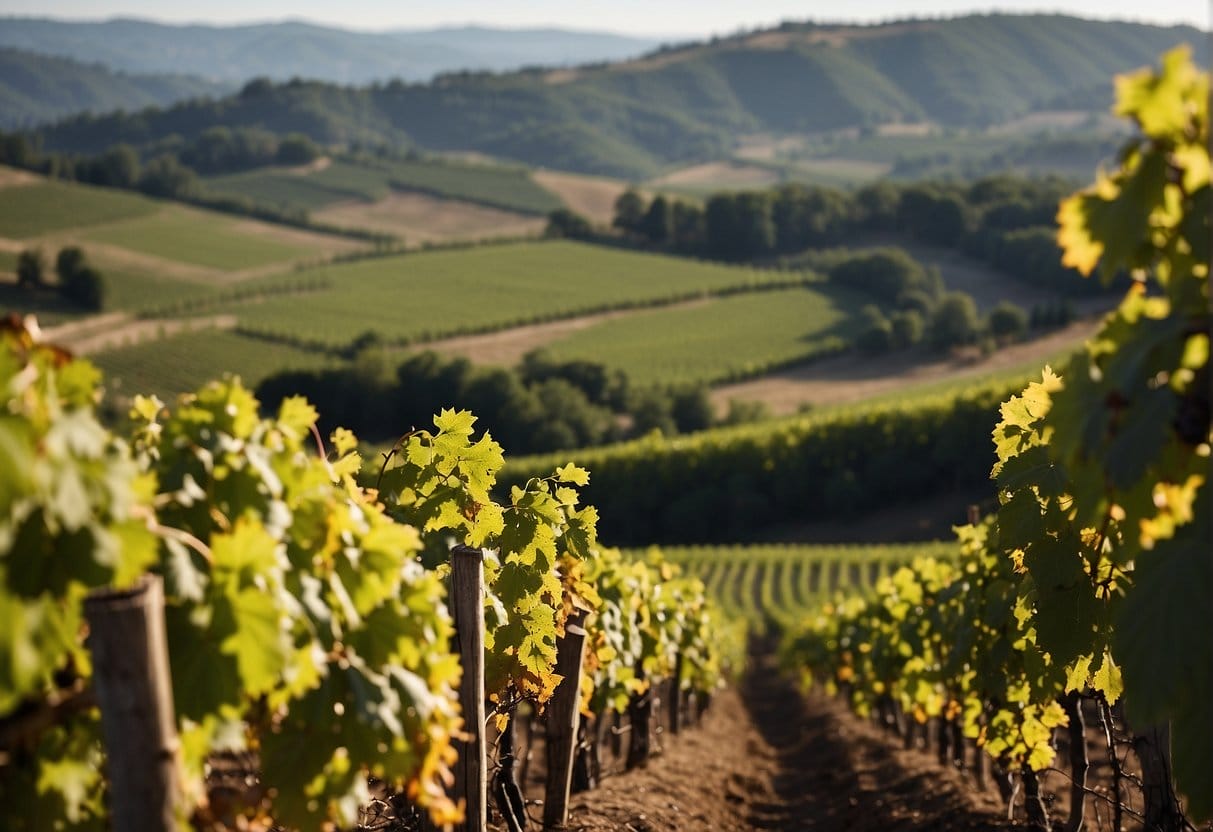
In exploring the revered Piedmont wine region, understanding its classification system is essential. Here, the designations of DOC (Denominazione di Origine Controllata) and DOCG (Denominazione di Origine Controllata e Garantita) play a pivotal role in upholding the quality and authenticity of Italian wines.
Understanding DOC and DOCG
Italy’s DOC system was established to ensure the quality of its wine by regulating the production area, allowed grape varieties, and winemaking techniques. It’s similar to the French AOC system and signifies a high-quality wine with characteristics tied to its specific region.
The DOCG mark raises the standard even higher. Wines with a DOCG classification adhere to stricter regulations, and there’s a guarantee of origin alongside quality. For every DOCG wine, there’s a link between the wine’s characteristics and its geographical origin. For instance, in Piedmont, both Barolo DOCG and Barbaresco DOCG reflect meticulous grape growing and winemaking rules, ensuring you savor a glass that’s a true expression of where it’s from.
Labeling and Wine Standards
When you select a bottle of Italian wine, the label serves as a guide to its quality level; looking for DOC or DOCG on the label is key. A DOCG label signifies the highest quality, often with a numbered government seal to prevent counterfeiting.
The regulations behind these labels protect the reputation of regions such as Piedmont, known for outstanding wines like Barolo and Barbaresco, by ensuring that every bottle meets or exceeds stringent production and tasting standards before reaching your table.
Viticulture and Winemaking
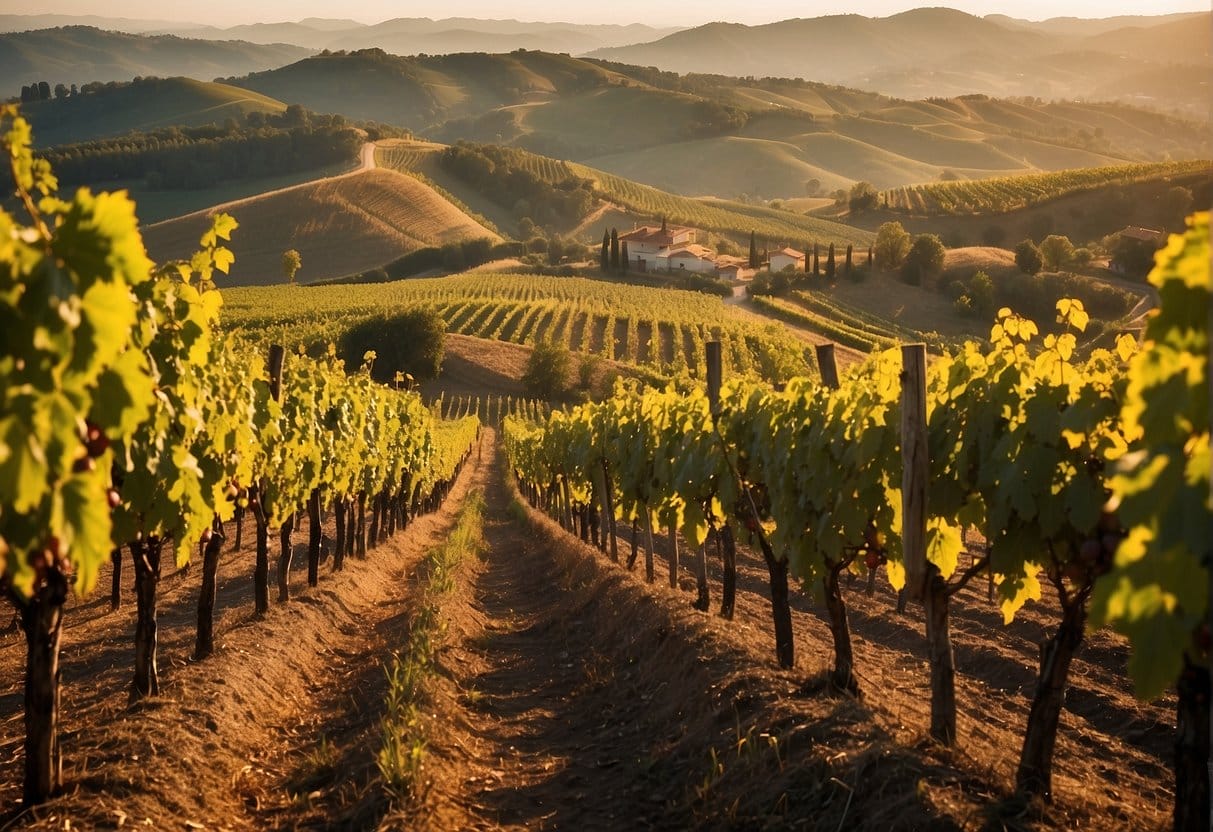
In the heart of northwest Italy, you find Piedmont, where the art of viticulture and winemaking is anchored in rich traditions, yet open to modern innovations that enhance the character of its wines.
Traditional Practices
Piedmont’s vineyards have deep roots in practices that date back centuries. The region’s winemakers hold terroir in high regard, understanding that the soil and microclimate uniquely influence the tannins and acidity in the grape, which in turn define the wine’s profile. As you walk through the rows of vines, you might notice the meticulous care with which each vine is tended.
- Dry farming: This method relies on natural rainfall, compelling the vines to develop deep root systems, which contributes to the rich complexity of flavors.
- Manual harvesting: By selectively picking the grapes by hand, winemakers can ensure only the best quality grapes are used, preserving the integrity of the wine.
These time-honored techniques contribute to the elegance and balance for which Piedmontese wines, such as the noble Nebbiolo, are known.
Modern Innovations
While treasuring tradition, Piedmontese winemakers have readily embraced modern innovations to refine their winemaking process.
- Controlled fermentation: Advances in temperature control during fermentation allow for more consistent and precise development of flavors and aromas.
- Barrique aging: The introduction of small, French oak barrels has enabled winemakers to imbue their wines with nuanced hints of spice and vanilla, enhancing complexity.
These modifications interplay with the ancient rhythms of the vineyard, showing that innovation can coexist with tradition to uphold Piedmont’s reputation for high-quality wines with a sense of place.
Pairing Piedmontese Wines
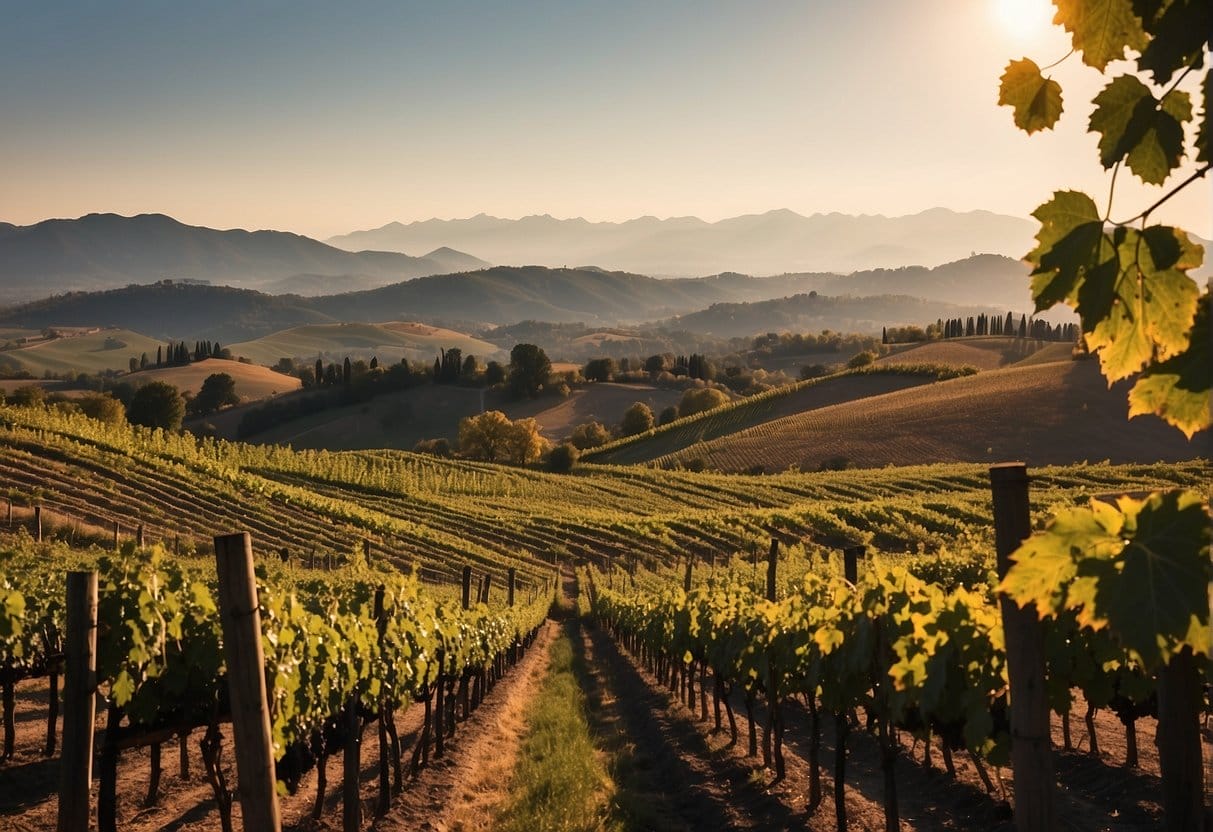
Piedmont, nestled at the foot of the Alps, offers an impressive array of wines that pair exquisitely with the region’s rich culinary offerings. Let’s explore how to best match these wines with food.
Food Companions for Red Wines
When enjoying red wines from Piedmont, such as Barolo or Barbaresco, which are typically robust and tannic, you’ll want to select dishes that can stand up to their intensity. Red meats and truffles are excellent choices. The high acidity and strong tannins in these wines cut through the fat and complement the flavors.
- Grilled steak: Bold Nebbiolo wines are a perfect match.
- Wild game: Enhances the earthy notes of a rich Barbaresco.
For a lighter red like Barbera d’Asti, which has a bright acidity and lower tannins, opt for:
- Pasta with tomato sauce: Complements the wine’s acidity.
- Pizza: The rustic character of a Barbera pairs delightfully with classic Italian pizza.
Selecting Pairings for Whites and Sparkling Wines
Your pairing choices can also shine when it comes to whites and sparkling wines from Piedmont. For the floral and often aromatic Moscato d’Asti, light desserts or fruit-based dishes can enhance the wine’s sweet profile.
- Fruit tarts: A semi-sweet Moscato d’Asti brings out the fruit flavors.
- Creamy desserts: The bubbles in a sparkling Moscato cleanse the palate.
Another renowned white, Gavi, which tends to have a crisp and mineral character, would be excellent with:
- Seafood: A chilled Gavi complements the delicate flavors of fish.
- Pesto pasta: Its vibrancy pairs nicely with herby sauces.
Remember, the key to pairing Piedmontese wines is to consider the body, acidity, and complexity of the wine, and match it with foods that share a balance in flavor intensity.
Visiting Piedmont’s Wine Country
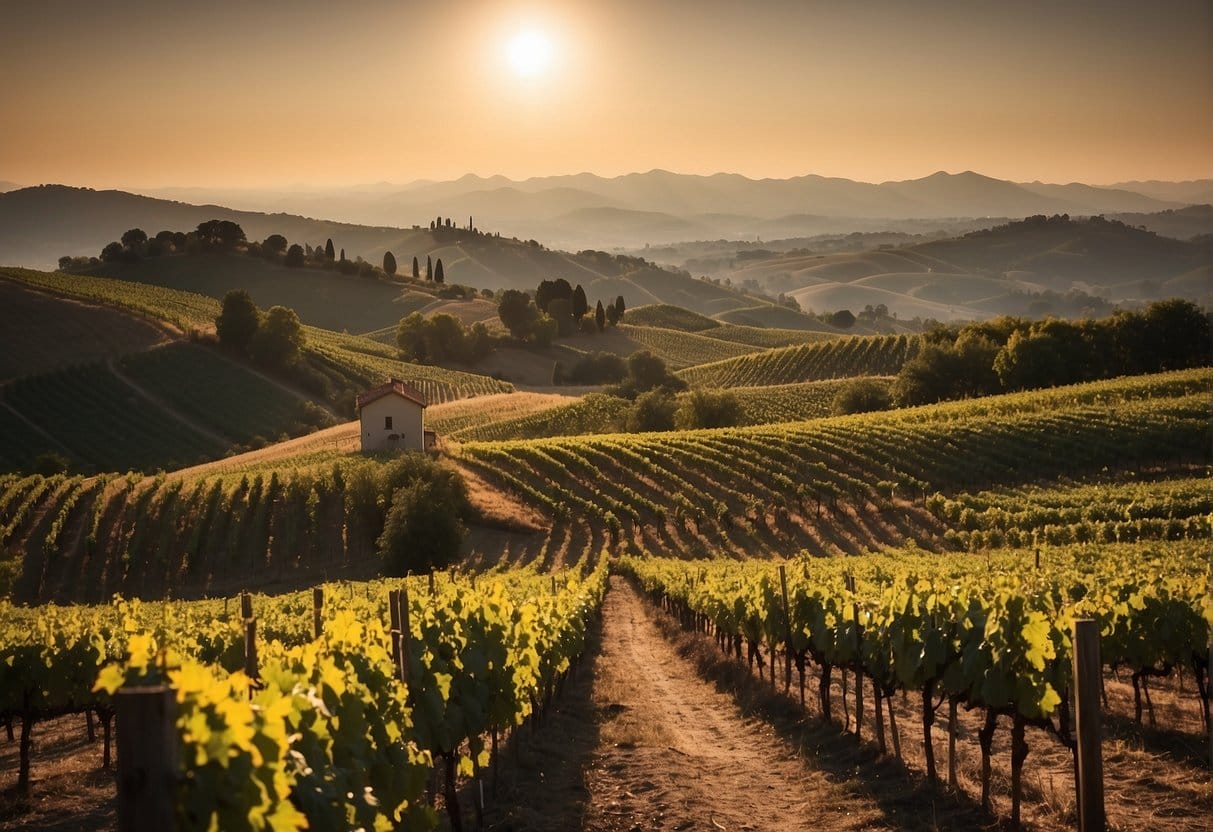
When you set out to explore Piedmont’s Wine Country, you’re not just embarking on a journey through rows of vine-laden hills; you’re also diving into a region steeped in cultural richness. Get ready to savor the famed wines, immerse yourself in historic towns like Alba, and let the vibrant city life of Turin surprise you.
Exploring Wine Routes
Touring the wine routes of Piedmont means getting acquainted with some of Italy’s most prestigious vineyards. Start your adventure in Alba, an epicenter for wine enthusiasts. Here, the vineyards stretch across the rolling hills with meticulously tended rows of vines, offering an up-close view of where iconic wines like Barolo and Barbaresco originate.
Dedicate a day or two to visit various wineries, each offering a unique glimpse into the winemaking process. Tastings are an integral part, so you can relish the rich, complex flavors that define this region.
- Suggested Vineyards to Visit:
- Vineyard A: Known for its robust Nebbiolo.
- Vineyard B: Offers a scenic backdrop for your tastings.
- Vineyard C: Specializes in aromatic Moscato wines.
Cultural Attractions and Activities
Piedmont is not just about wines; it’s a cultural haven too. Your tour wouldn’t be complete without visiting the grand city of Turin, prominently displaying its baroque architecture and bustling city squares.
Museums and galleries abound, but make sure to take a walk along the Po River for a serene break from the city vibes. The historic town of Alba, famous for its white truffles and medieval structures, hosts markets and festivals that will engage your senses. Combine your love for wine with a taste of Piedmontese culture at these events.
- Activities to Experience:
- Visit the Alba Truffle Festival in autumn.
- Explore Turin’s Egyptian Museum or the Mole Antonelliana for a dose of history and architecture.
- Enjoy a leisurely hike through the Langhe hills, a UNESCO World Heritage site perfect for panoramic views of the wine region.
Follow these paths and you’ll not only enjoy the finest wines but also enrich your travels with the soul of Piedmont.
Prominent Wineries and Producers
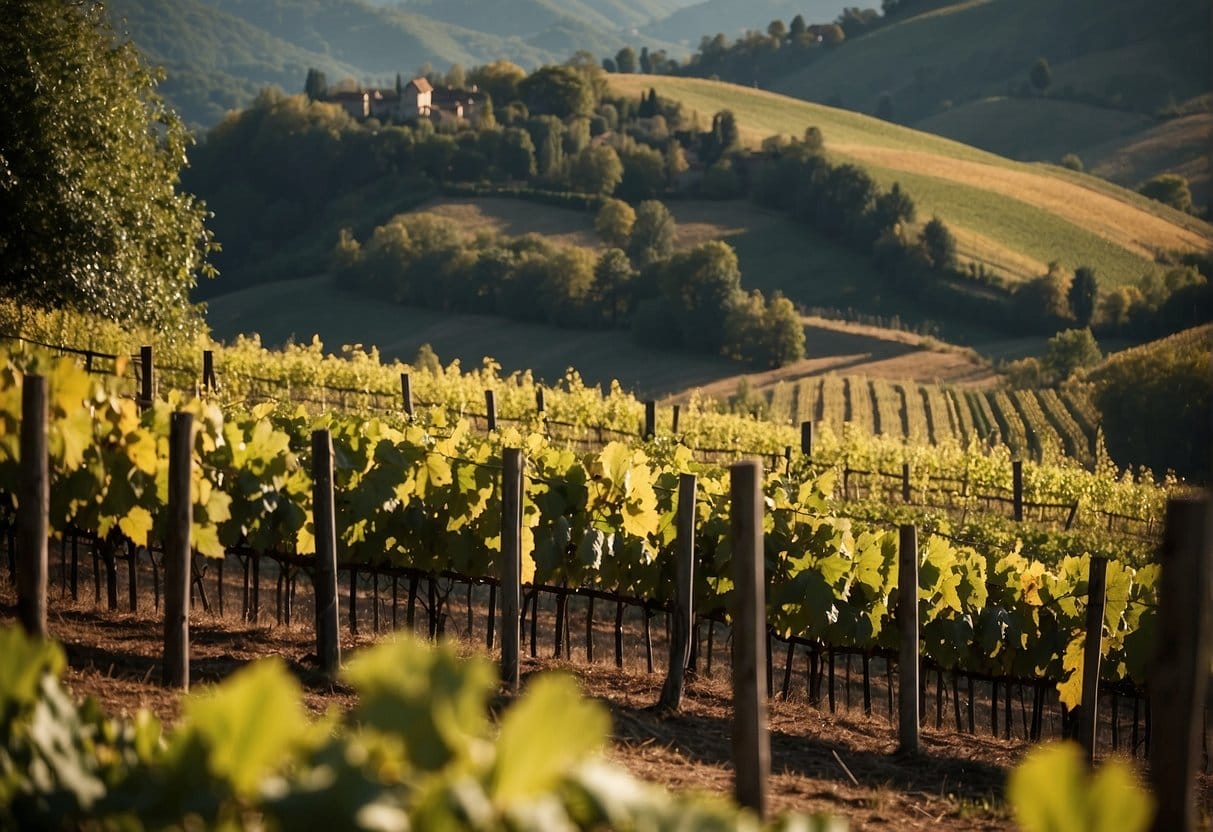
Piedmont’s rolling hills offer more than just breathtaking views; they are the birthplace of some of the world’s most revered wines. You’ll discover wineries with deep historical roots and innovative producers redefining Piedmontese wine.
Iconic Barolo Producers
In the heart of Piedmont, Barolo is known as the “king of wines,” and with good reason. Its producers like Cordero di Montezemolo are renowned for their deep history and commitment to tradition. You’ll find Montezemolo’s winemaking goes back 19 generations, offering you a taste of legacy. Their vineyards are not only scenic but produce some of the most complex and cherished Barolo wines.
Another titan of the Barolo region is Camillo Benso, often referred to as the Count of Cavour. His influence on Piedmontese wines is legendary; his passion and political prowess were central to their rise in prominence.
Influential Barbaresco Winemakers
Moving on to the Barbaresco wines, which are often considered the queen to Barolo’s king, the winemakers here carve their own distinct reputation. These wines are admired for their finesse and are crafted by winemakers deeply in-tune with the land. Pio Cesare, established in 1881, offers you a historical lineage blended with innovative practices. These winemakers are committed to maintaining the integrity of the Barbaresco name while evolving with contemporary techniques.
Innovators and Upcomers
The Piedmont region isn’t just about the old guards. Innovators and upcomers are making a mark, balancing respect for local traditions with a fresh perspective. Check out the work at vineyards like Pelassa, known for elevating the essence of Piedmont wines. Their Roero and Monferrato wines reflect the region’s diversity, showcasing creative blends and bold approaches to winemaking. They represent the bridge between Piedmont’s storied past and its dynamic future.
Frequently Asked Questions
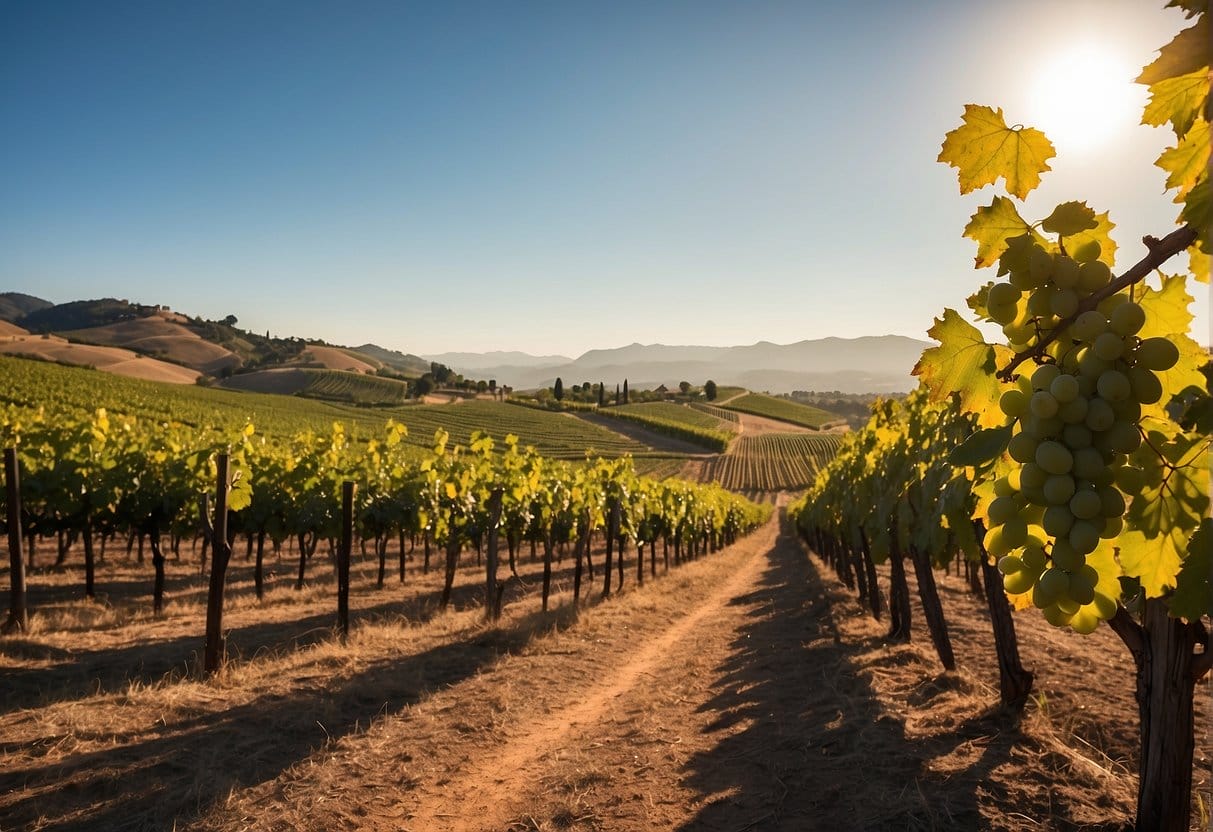
Before you venture into the famed Piedmont wine region, get answers to common curiosities about its wines and travel tips that could enhance your experience.
What are some of the top wines one should try from the Piedmont region?
When visiting Piedmont, you should definitely try Barolo and Barbaresco, both of which are made from the Nebbiolo grape and are renowned for their depth and complexity. Don’t miss out on tasting Dolcetto and Barbera, which offer a more fruit-forward palate.
Can you recommend any notable white wines from Piedmont?
Absolutely, Moscato d’Asti is a must-try as it is a lightly sparkling, sweet wine that’s perfect as an aperitif or with dessert. The region also produces Gavi, made from Cortese grapes, which you’ll find to be refreshing and crisp.
In which part of Northern Italy is the Piedmont wine region located?
You’ll find the Piedmont wine region nestled at the foot of the Alps in the northwestern part of Italy. This proximity to the mountains gives the area a unique climate ideal for viticulture.
What are some accommodations options when visiting the Piedmont wine region?
You can stay in a range of accommodations, from luxurious hotels to cozy bed and breakfasts. For an immersive experience, consider booking a room at a vineyard estate or agriturismo.
What’s the best way to explore the Piedmont wine region for wine lovers?
To truly immerse yourself, consider a guided wine tour which will provide you with in-depth knowledge, or rent a car to explore at your own pace. Both options will give you the chance to visit various wineries and taste the distinctive wines of the region.
Which red wines are considered the flagship varieties of the Piedmont region?
Nebbiolo takes the crown as the flagship red wine grape of Piedmont, giving life to the prestigious Barolo and Barbaresco wines. However, Wines like Barbera and Dolcetto are also considered important red varieties, offering a diverse taste of Piedmont’s viticultural prowess.
